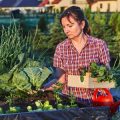Introduction to Budget-Friendly Food Preservation
If youve spent all season growing your own vegetables, herbs, and fruits, youre probably wondering how to make the most of your harvest. The good news? You don’t need fancy or expensive equipment to preserve your homegrown food. In fact, many traditional preservation methods can be done with tools you already have in your kitchen. Learning how to store your harvest properly not only helps reduce waste but also saves you money and allows you to enjoy your gardens bounty long after the growing season ends.
Preserving food at home has a few key benefits:
- Cost-effective: No need for high-end dehydrators or vacuum sealers.
- Healthy: You control what goes into your preserved food—no additives or preservatives.
- Satisfying: Theres something special about opening a jar of homemade tomato sauce in the middle of winter.
You might be surprised at how easy it is to get started using basic techniques like freezing, drying, fermenting, and canning with items you likely already own. Below is a quick comparison of common low-cost preservation methods:
| Method | Best For | Basic Tools Needed | Storage Time |
|---|---|---|---|
| Freezing | Berries, green beans, corn | Freezer bags, baking sheet | 6–12 months |
| Drying | Herbs, apple slices, tomatoes | Baking tray, oven or sunny spot | Up to 1 year |
| Fermenting | Cabbage (sauerkraut), cucumbers (pickles) | Mason jars, salt, water | Several months (refrigerated) |
| Water Bath Canning | Jams, jellies, tomatoes | Large pot, mason jars, tongs | Up to 1 year or more |
No matter how big or small your harvest is, preserving it doesn’t have to break the bank. With just a little effort and some everyday kitchen tools, you can stretch your garden’s rewards throughout the year.
2. Canning Without Fancy Gear
Canning is a time-tested way to preserve your harvest, and you don’t need expensive equipment to get started. With just a few basic kitchen tools, you can safely can fruits, vegetables, and even homemade jams right at home.
Essential Tools You Probably Already Have
- Large pot with lid: This will act as your water bath canner.
- Mason jars with lids and rings: These are necessary for storing your canned goods.
- Tongs or jar lifter: Helps safely remove hot jars from boiling water.
- Clean towels: For wiping jar rims and placing hot jars on a safe surface to cool.
- Ladle and funnel (optional but helpful): Makes filling jars easier and less messy.
Step-by-Step: Water Bath Canning Basics
- Sterilize your jars: Boil them in water for 10 minutes or run them through a hot dishwasher cycle without detergent.
- Prepare your food: Wash, peel, chop, or cook your produce as needed. Hot pack or raw pack based on the recipe.
- Fill the jars: Use a funnel if available. Leave proper headspace—usually about ½ inch for jams and jellies, and 1 inch for vegetables.
- Wipe the rims: Use a clean damp cloth to ensure a good seal.
- Add lids and rings: Tighten finger-tight, not overly tight.
- Process in boiling water: Place jars in the large pot with enough water to cover by at least one inch. Boil for the time recommended in a trusted canning guide (varies by food type).
- Cool and store: Carefully remove jars using tongs. Place on a towel-lined surface and let sit undisturbed for 12–24 hours. Check seals before storing.
Canning Times for Common Produce
| Produce | Packing Method | Processing Time (Pint) | Processing Time (Quart) |
|---|---|---|---|
| Tomatoes (crushed) | Hot Pack | 35 min | 45 min |
| Pears (halved) | Hot Pack | 25 min | 30 min |
| Dill Pickles | Raw Pack | 10 min | 15 min |
| Salsa | Hot Pack | 15 min | N/A |
| Straight-up Jam (Strawberry, etc.) | Hot Pack | 10 min | N/A |
A Few Safety Tips to Keep in Mind
- If youre new to canning, stick with high-acid foods like fruits, pickles, and tomatoes (with added lemon juice) — these are safer for beginners using the water bath method.
- Avoid altering tested recipes when it comes to acid levels or processing times — this helps prevent spoilage and ensures safety.
- If a jar doesn’t seal properly after cooling, refrigerate it and use within a week instead of storing it on the shelf.
No Pressure Canner? No Problem!
You don’t need a pressure canner unless you’re preserving low-acid foods like green beans or meats. For everything else — jams, pickles, fruit sauces — your basic kitchen setup will do just fine. Keep it simple and safe, and enjoy your garden’s bounty all year long!

3. Freezing Techniques with Everyday Supplies
Freezing is one of the easiest and most accessible ways to preserve your garden harvest—no fancy equipment required. All you need is a standard home freezer, some basic containers or resealable bags, and a little know-how to keep your fruits and veggies fresh for months.
What You Can Freeze
Many fruits and vegetables freeze well, especially if they’re prepared correctly. Here’s a quick look at common garden produce that freezes nicely:
| Vegetable/Fruit | Prep Needed | Freezing Tip |
|---|---|---|
| Green beans | Trim ends, blanch 2-3 mins | Cool quickly before bagging |
| Tomatoes | Chop or puree | Great for sauces and soups later |
| Zucchini | Grate or slice, blanch 1-2 mins | Perfect for baking or stir-fries |
| Berries (strawberries, blueberries) | Wash and dry thoroughly | Freeze in single layer first to avoid clumping |
| Herbs (basil, parsley) | Chop or blend with oil or water | Freeze in ice cube trays for easy portions |
Everyday Freezer Supplies You Can Use
You don’t need vacuum sealers or fancy gadgets to freeze your food properly. These everyday items work just fine:
- Resealable freezer bags: Great for portioning out veggies or fruits. Squeeze out as much air as possible before sealing.
- Plastic containers: Ideal for soups, sauces, or chopped produce. Leave a little room at the top for expansion.
- Iced cube trays: Perfect for freezing small amounts of herbs, pesto, or even tomato paste.
- Baking sheets: Use them to pre-freeze items like berries or veggie slices before transferring them into bags—this prevents clumping.
Quick Tips for Best Results
- Label everything: Always write the date and contents on your container or bag so you don’t lose track of what’s inside.
- Avoid freezer burn: Push out excess air from bags and use airtight containers to help prevent drying out.
- Keep portions small: Freeze in meal-sized portions so you only thaw what you’ll use.
- Categorize by use: Keep separate bags for smoothie fruits, stir-fry veggies, and soup starters to make meal prep easier later on.
Your regular freezer can go a long way in helping you enjoy your garden bounty all year round—no expensive tools necessary!
4. Drying and Dehydrating Naturally
Drying is one of the oldest and simplest ways to preserve your harvest, and the good news is—you don’t need fancy equipment to do it. Whether you’re working with herbs, fruits, or veggies, there are easy methods you can use right at home.
Air-Drying Herbs
Herbs are perfect candidates for air-drying. It’s a hands-off method that works best in dry climates with good airflow. Here’s how to do it:
Steps to Air-Dry Herbs
- Choose fresh, healthy herbs—avoid any with signs of disease or pests.
- Rinse gently and pat dry completely using a clean towel.
- Gather small bunches and tie the stems together with string or a rubber band.
- Hang upside down in a warm, dry, well-ventilated area out of direct sunlight.
- Let them dry for 1–3 weeks until leaves crumble easily between your fingers.
Using Your Oven to Dehydrate Produce
If you don’t have a dehydrator, no problem—your kitchen oven can get the job done. This method works well for sliced fruits like apples or pears, and even vegetables like tomatoes or zucchini.
Basic Oven Dehydration Guide
| Produce Type | Preparation | Oven Temp | Time Estimate |
|---|---|---|---|
| Apple slices | Core and slice 1/4 inch thick | 140°F (60°C) | 6–8 hours |
| Zucchini chips | Slice thinly and season if desired | 140°F (60°C) | 5–7 hours |
| Tomato halves | Scoop seeds and place cut-side up | 140°F (60°C) | 8–10 hours |
Leave the oven door slightly ajar to allow moisture to escape, and check every few hours for doneness.
Storing Dried Goods Properly
The key to long shelf life is keeping moisture out once your produce is dried. Here are some tips:
Dried Food Storage Tips:
- Use airtight containers like mason jars or vacuum-sealed bags.
- Add food-safe silica gel packets to absorb any leftover humidity.
- Store in a cool, dark pantry or cupboard away from heat sources.
- Label each container with the contents and date of drying.
Dried foods can last several months to over a year when stored properly, making this method a low-cost way to enjoy your gardens bounty all year long.
5. Creative Storage Solutions and Tips
Preserving your garden harvest doesn’t require fancy machines or expensive tools. With a little creativity and some time-tested methods, you can keep your fruits and vegetables fresh for months. Below are a few traditional, low-cost ways to extend the life of your produce while adding flavor and variety to your meals.
Pickling
Pickling is one of the easiest and most flavorful ways to preserve vegetables like cucumbers, carrots, beets, and even green beans. All you need is vinegar, water, salt, and optional spices like garlic, dill, or peppercorns. You can quick-pickle in the fridge or use a basic water bath canning method for longer storage.
Basic Refrigerator Pickle Recipe
| Ingredient | Amount |
|---|---|
| White vinegar | 1 cup |
| Water | 1 cup |
| Kosher salt | 1 tbsp |
| Sliced veggies | Enough to fill a jar |
Combine vinegar, water, and salt in a saucepan; bring to a boil. Pour over vegetables packed in a clean jar. Let cool, then refrigerate. Ready in 24 hours!
Fermenting
Fermentation not only preserves food but also boosts its nutritional value by adding beneficial probiotics. Cabbage (for sauerkraut), carrots, radishes, and even garlic are great candidates for fermentation. All you need is salt and a clean jar—no electricity or gadgets required.
Simple Sauerkraut Guide
- Shred cabbage and mix with 1 tbsp of salt per pound.
- Massage until it releases liquid.
- Pack tightly into a jar so the cabbage stays under its own brine.
- Cover loosely and let it sit at room temperature for 1–2 weeks.
Taste every few days until its as tangy as you like, then store it in the fridge.
Root Cellaring
If you have a cool basement or even an unused closet that stays dark and cold during winter months, you can mimic old-fashioned root cellaring techniques. This method works well for storing hardy crops like potatoes, carrots, onions, squash, and apples.
Ideal Conditions for Common Crops
| Crop | Temperature (°F) | Humidity Level |
|---|---|---|
| Carrots | 32–40°F | High (90–95%) |
| Potatoes | 40–50°F | High (85–90%) |
| Onions | 32–35°F | Low (65–70%) |
You can store root vegetables in boxes filled with damp sand or sawdust to maintain humidity. Just be sure they’re not touching each other to avoid rot spreading.
No-Fuss Tips for Extra Shelf Life
- Avoid washing produce before storage—moisture speeds up spoilage.
- Use breathable containers like baskets or paper bags instead of plastic bags.
- Label everything with dates so you use older items first.
You don’t need high-end equipment to enjoy your harvest all year long. These creative yet simple methods help you get the most out of your garden without spending extra money on gadgets or electricity.


